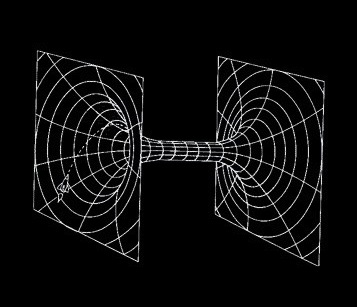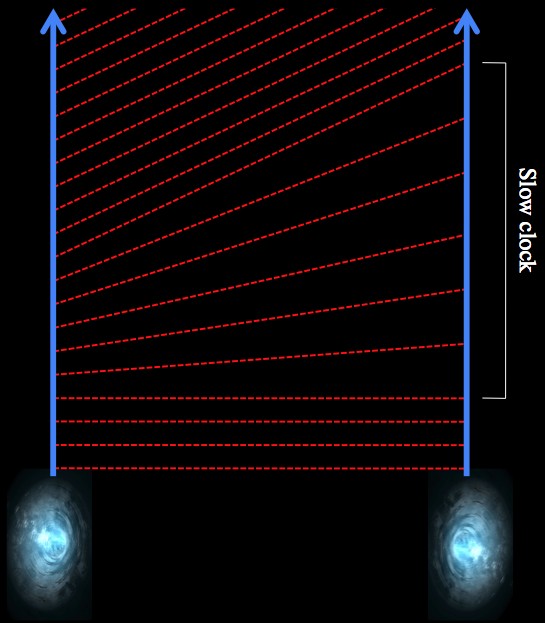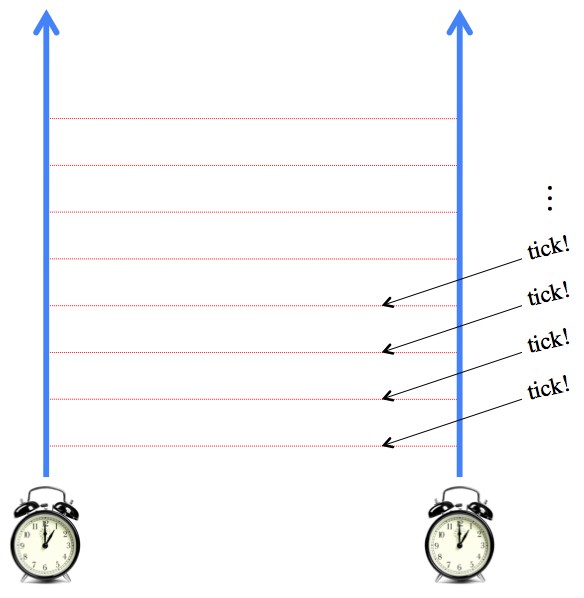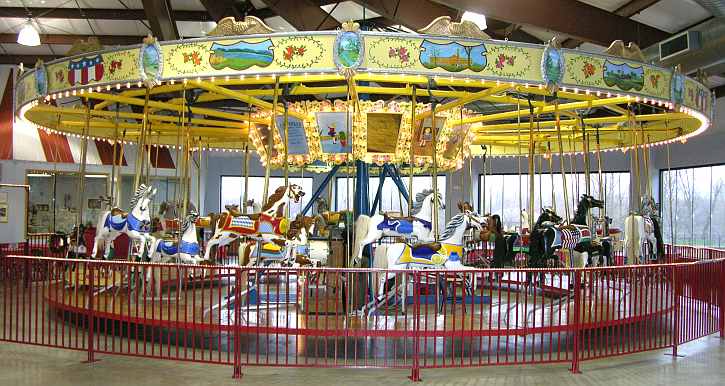Physicist: A good way to think about a wormhole is as a single region of space. That is, while the ends may be in two different locations, the wormhole itself is a single “piece of space”.

A wormhole, despite having ends in two very separated regions of space and/or time, is still a single chunk of spacetime. You can move the ends to any location or time you want; the inside stays the same.
So, even if you move the entrances far apart, the distance you travel from one side to the other always stays the same. Similarly, even if you move the entrances far apart in time, the time it takes to get across them stays the same in very much the same way.
That shouldn’t make much sense (if it did, sober up), but here’s the idea:
The two ends of the wormhole will always be connected to each other such that they’re always connected at the “same age”. So, if you enter one end 5 years after the creation of the wormhole, you’ll exit the other end 5 years after the creation of the wormhole, no matter where the ends are located.
Two synced clocks on opposite sides of a room will stay synced up. The nature of the space between them isn’t particularly important. For example, if the space between them is, say, a wormhole instead of a sitting room, they’ll still stay synced up.
This has exciting potential for time-machine building. If you can somehow get one side of the wormhole to experience more or less time, from an outside perspective, then, from that outside perspective, you’ll have a difference in ages between the ends of the wormhole.

If you can get the ends of the wormhole to move through time at different rates, then the ends will be different ages. Here, the clock and wormhole mouth on the left are allowed to move through time normally. The clock and wormhole mouth on the right are forced to experience less. Looking through the wormhole you find that the clocks are still synced, but from outside the wormhole, the left side is older, and the right side is younger.
Luckily, relativity (both special and general) gives us some tricks for slowing down the amount of time an object experiences. Taking advantage of the twin paradox (special relativity), you can take one end of the wormhole and move it (never mind how) at very high speeds for a while. When it’s brought back to rest, its clock will register less time than its stationary counterpart. Alternatively, you can take advantage of gravitational time dilation (general relativity). Time moves “slower the lower“. So, if you park one end of the wormhole in orbit around a black hole or something else heavy, then it will also experience less time.
So, say you’ve created a wormhole. Never mind how. You take entrance B, attach it to a ship and fly it around at nearly the speed of light (doesn’t matter where), and then bring it back, while entrance A sits still. While entrance B experiences 5 years (for example), entrance A experiences 5,000 years (for example). Now you’ve got two entrances, but one is 5 years old and the other is 5,000. Since they’re “connected at the same age”, stepping through the B entrance will take you back to the time when the A entrance was 5 years old, which was 4,995 years ago. Similarly, stepping through the A entrance would take you to the time when the B entrance is 5,000 years old, 4,995 years in the future (assuming there’s no further wormhole moving). In the picture above A is on the left and B is on the right.
As for how exactly the mechanics of time travel works, what with grandfather paradoxes and what not, I couldn’t say. That’s more of an “ask a sci-fi writer” sort of thing.
The methods used to create, stabilize, and move wormholes generally involve some pretty abstract (“abstract” = “impossible”) math and physics. General relativity, among other things, gives us a way of relating the curvature of space to the distribution of matter and energy in that space. So, for example, you can figure out how the presence of a star’s worth of mass will affect the spacetime around that star.
Alternatively, you can back-solve. You take the weird spacetime of a stable wormhole, do a mess of math to figure out how you’d need to arrange matter, and find that in general wormholes need a whole lot of negative energy and matter. The drawbacks of negative matter, sometimes called “exotic matter”, are: 1) it’s very difficult to work with and 2) it doesn’t exist.
However, the tricks used to slow down time are legitimate science! Here’s a fun home experiment: Find yourself a merry-go-round. One of the big ones, with the horses and the brass band and whatnot. The twin paradox applies to anything that makes a round trip. So, every time you make a full turn you’ll have experienced about 0.4 femtoseconds (0.0000000000000004 seconds) less than everyone else. That’s forward time travel!
But be warned, you’ll be cursed to live in the future forever. Never able to go back and warn people about the misfortunes of their extremely near futures.









My immediate (and only hazily analysed) thought about the “grandfather paradox” is that it would be impossible for situation to arise
The grandfather would have to be on the “past” end of wormhole which has at some point been forced to undergo time dilation , while grandson would have to start on the “normal” (+4995 yr) side.
If your grandfather sired a son before the dilation process started then killing him at any point afterwards (which is only possibility as you can’t travel back to before this dilation started) is of course no paradox.
If he sires a son after process starts then the son or grandson has to somehow leave this “past” spacetime location and move to “future” spacetime location, presumable through the wormhole.
This is where I start to get hazy but I have hunch that as clocks are still “ticking synced” he would experience moving rapidly forward in time as he approaches the future end. But if he turns back he can never returns to a time prior to when he left the past. So he can never reach a point in spacetime before his birth, hence paradox cannot occur.
additional note – picture it this way; the son or grandson has to move fixed through the wormhole along one of those red dotted lines on diagram from left to right.
So it becomes clear he cannot ever get onto one of the “earlier” red dotted lines.
Similarly for everyone on the future side, there would be a limit (maybe?) that for every tick in their timeframe there is a tick in the past, so they will no longer be able to access past time before that tick. Of course they are experiencing time greatly increased. So for example for every year in their frame a second passes in the past and this is a rolling limit on how far back they can go.
And now my brain starts to hurt.
oh god sake – i think I have everything back to front (past is right on diagram not left). However I think the principles mainly still apply.
Im not sure about the concept of wormholes. wouldnt wormholes violate the thing about how nothing, even information, can travel faster than light?
Absolutely.
They cause plenty of problems.
Hmm my previous post I overlooked the very important point that the two ends of the wormhole don’t have to be spatially distant. Which means it may be entirely possible to create a grandfather paradox.
Which suggests our concepts of either causality or spacetime are quaintly naive. My personal view is future advances in physics will probably reveal wormholes as having been spurious theoretical artifacts.
Either that or the moment you start playing with them the brane-police arrive and tell you to stop trying to break the universe.
If the many worlds hypothesis is correct, time travel poses no grandfather paradox problems as you’re not actually going back to your past (or seeing your future).
Take your concept of time as a line, with the origin as the present and a cone as the possible futures; Then stretch it out over another dimension (where each of the alternate universes lie in parallel). Now you have a fuzzy dot that comprises the uncertainty of ‘now’ and a fuzzy cone for ‘future’ but a smaller cone for ‘past’. Past is uncertain because there’s actually an infinite number of pasts that are consistent with the present state. Each perceived time-line is just one possible arrangement.
The only way you can change your perceived past is if it already happened! In other words, you can only kill your grandfather if you already killed your grandfather (and thus, your grandfather isn’t who you thought it was). Otherwise, it’s just another branch off from the state at which the change occurred. In this case, where a strange alternate version of a person’s lineage shows up and kills them before they can have kids.
The simpler take on it is why the hell are you trying to kill your grandfather in the first place!?
He knows what he did.
I like to move it move it.
How do you “move it (never mind how) at very high speeds”. (the wormhole-end)
A craftsman approach would be installing a drawbar to the wormhole-end and hooking it up the trailer hitch on your volvo. But I guess it’s really hard drilling a hole into the wormhole (in order to install the drawbar with some.. spacetimescrews).
I suggest a spacetime-coated diamond driller.
Pingback: Carnival of Mathematics #84 Mathematics and Multimedia
I found a neat FAQ that succinctly discusses these issues and many more. It appears to be an excerpt from The Physics of Stargates by Enrico Rodrigo.
If you want to get older than your twin, put him on one of the poles and set yourself on the equator. This way you will be at the end of your life around 1-2ms older. 🙂
We have all seen the 3 dimensional graphical representation of space-time being warped by gravity(bowling ball on a trampoline, etc), but is there any real reason to think that this mechanism for understanding gravity is literally true? That is, is it really bent in a way that would cause one point in space to contact another?? Or are people taking the illustrative explanation too literally??
As what Kevin was saying I think what he meant was if you when back in time and killed your Grandfather… There will be a branching dimension or parallel universe where you never existed and the universe where you where born and (for some reason) killed your Grandfather.
Reference = Anime = Steins Gate
grandfather paradox goes hand in hand with MWI, with some flexing of the imagination…
starting in universe 1, you find yourself with a dislike for your progenitor. going back in time to do the deed could only occur in a universe where you do not end up coming into existence. therefore, every time you time travel (backward) you are effectively re-writing the history or conversely, from this second universe’s point of view, you spontaneously materialized at a time you know as ‘your past’ with a coincidence that later on something resembling you will be born in this universe, called universe 2 (if you don’t interfere with anything at all).
in universe 2 you, due to your actions, will not be born. as such you never go to universe 3, where you are able to be born and go back in time to universe 4, and so on…
this starts to look very much like a QM problem – half the possible realities where you could exist, become invalid by you going back in time and preventing your own birth. i would go so far as to say this is another analogy for wavefunction collapse.
Pingback: Antara Sains dan Fiksi dalam Interstellar | Birokreasi
But how it is possible
The wormholes makes travel to the past time,but only for the future using the time dilatation,it could see the things happen before than the others that are out of the wormholes
Hello sir , I have a bunch of questions inside my mind which is really bothering and keeping me awake at night for a long time. According to general theory of relativity, time slows down at high speeds and come to an end when it reach light speed and so the mass of the object becomes infinite. So imagine that I am travelling in a spaceship at light speed. Does the spaceship becomes infinitely massive and create a gravitational field which is infinitely strong? Does the entire universe, sucked inwards to the spaceship which is infinitely massive? How do I experience the time inside the space ship? If the time itself would come to an end at light speed, how could the space ship move ? (I mean, isn’t time required for an object to travel from one place to another ?) I don’t know whether I am wrong or not, however if I am wrong, I
humbly request you to correct me (Don’t make fun of me if am asking
a foolish question)